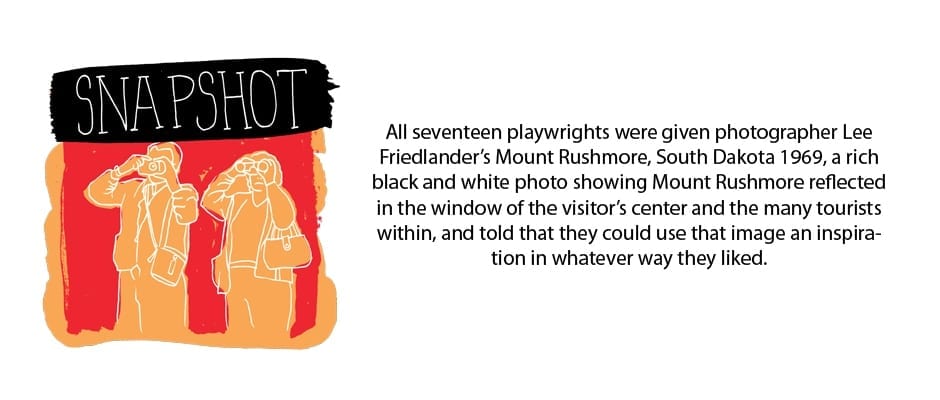
SALT LAKE CITY — What do you get when you give seventeen playwrights a single photographic image as an inspirational starting point? The answer: Snapshot, a play that is more than the sum of its many and varied parts.
The work was commissioned by the Actors Theatre of Louisville and premiered as part of the Humana Festival of New Plays in March of 2002.
All seventeen playwrights were given photographer Lee Friedlander’s Mount Rushmore, South Dakota 1969, a rich black and white photo showing Mount Rushmore reflected in the window of the visitor’s center and the many tourists within, and told that they could use that image an inspiration in whatever way they liked.
The resulting collage of scenes is a great piece for a college theatre program, allowing a wide variety of characters and situations to be explored while giving every actor a moment or two in the spotlight.
One of the first scenes, titled Monument, was about emergency response phone operators during the World Trade Center attacks. The scene was beautifully staged and brought me to the verge of tears. Though several of the scenes take place at or around Mount Rushmore, many did not. But there were threads and common themes that seemed to tie them all together. Themes like memory, patriotism, mortality, and identity were woven throughout.
Highlights of the evening include Ana Lemke‘s performance in American Klepto, about a woman who struggles to justify keeping a piece of petrified wood lifted from a National Park; and Marin Kohler’s hilarious characterizations in both Thrift of the Magi (as a self-conscious hipster in a thrift store) and in Becoming America, where she teaches a room full of new employees at an American-owned call center in Africa how to sound more American while providing customer support to clients in the States.
Paul Chaus gives a nice turn in Here and Now, handling a very long and challenging inner monologue that is filled with beautiful and complex language with ease.
Actress Jessica Lee shows some touching fragility in The Great Father, and in Rock, Scissors, Paper—playing in both as psychologically traumatized victims of sorts, trying to come to terms with the world.
One of the scenes, On Lincoln’s Head, was written by local Utah playwright Julie Jensen and turned out to be one of my favorite scenes of the evening. Jensen has a real knack for creating relatable characters in fantastic (but totally believable) situations.
My least favorite piece was Scene at Mount Rushmore, which just didn’t live up to the caliber of the rest of the evening. The staging was awkward, the acting was stiff, and though the scene had a nice ending, I was unimpressed with the rest of it.
The set design was great—four boxes that transformed from scene to scene from benches to computers to guardrails and more.
I was less impressed with the Costume design, which partly consisted of a base layer for all the actors of white clothing with grey spatters. I’m not sure if the designer was going for a rock texture like that of Mount Rushmore itself or something else, but it ended up looking like the snow camouflage that soldiers wear. The fact that many of the characters were park rangers compounded the problem for me. At times, I felt like I was watching a patrol of Artic force army rangers.
Another element of the show that rubbed me the wrong way was the sound design, which featured popular American songs past and present—some of which were re-recorded on a midi synthesizer and sounded just awful. The song choices were fine, I just didn’t understand why some had been re-recorded.
My final complaint was with the scene changes. Though I loved the transforming set boxes, I was disappointed that the transformations from scene to scene were so clunky. Not that anything malfunctioned or took too terribly long, but for every change the same thing would happen: lights go to half, actors exit, run crew enters and changes scene, run crew exits, actors enter, lights come up. Scene changes have to happen, it’s one of the facts of theatrical life–but with a solid ensemble full of entertaining actors and a loosely-structured contemporary collage text, I feel like there was a missed opportunity there to make the transitions from scene to scene more interesting.
The show finishes off with Bomb Squad, where actor Christian Seiter finally gets to use his fun and quirky physicality to his full potential as a prophetic stripper who has come to work his mojo on the visitors and staff at the monument. Director Hugh Hanson made a strong choice here to work many of the characters and relations from previous scenes into this final portrait, which really unified the entire show for me and brought things to a solid and entertaining close.
Snapshots at the University of Utah is a wonderful collaboration from a great team. Though not without a few rough edges and a few of the stories closer to sketches rather than fully realized portraits, you’ll enjoy the many emotionally powerful moments and thought-provoking writing from some of our nation’s freshest voices—writers and actors alike.
[box type=”shadow”]Snapshot was produced by the University of Utah and closed on November 20, 2011. It performed in Studio 115 on the campus of the University of Utah in Salt Lake City. More information on this and future productions at Studio 115 can be found online at Theatre.Utah.edu.[/box]
